Väre
Otaniementie 14
School of Arts, Design and Architecture
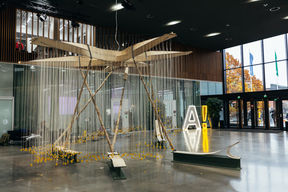
“Zero Gravity 2.0” emerges as a multidisciplinary result of design thinking strategies, complex kinematics and geometry-driven structural design. It merges disciplinary aspects that have never been combined before into a user-responsive, super-lightweight spatial experience. It creates an ephemeral space.
Visions, ideas and thoughts have zero gravity. That is where everything begins.
As our man-created environment is about to overcome Euclidean Geometry, as our materials are getting smarter and lighter and as our processes are informed by data and fabrication technology, our structures will increasingly represent a merger of designed space and performance. To achieve qualities of lightness, adaptivity and ephemerality the challenge is how to create more by using less.
Lightness is only partly a matter of material. Lightness is gained by structural understanding. Architectural geometry is a tool that links structure, space and fabrication, rather than its mere representation.
Adaptivity is premised on lightness. The lighter a structure is, the more efficient it is in kinematics and many other regards. “Zero Gravity 2.0” is both adaptable and adaptive. Its modified 6 degree-of-freedom mechanism allows for motion that is actuated by the interaction of user and structure.
Ephemerality here refers to indefinite and transitory timelines, qualities of the temporary, rather than the binary of short-term and long-lasting. Transferred to our built environment this means that in future we have to rethink the timespan of our buildings, cities and infrastructure. Whatever we create has to provide the possibility to disappear without a trace after it’s appropriate time of use, where the “appropriate” defines the time-span.
In the age of Anthropocene, new approaches to sustainability are in urgent demand. The construction sector is one of the major contributors to environmental burden.
>40% of the total energy consumption and >36% of CO2 emissions conflict with the declared European targets. It’s clear we must combine designing appropriate forms and responsible selections of used materials, with thinking in life-cycles. Fabrication, assembly, use, disassembly and re-use have to be considered in a complex design thinking process, which aims for environmentally compatible and mind-elevating solutions.
Most objects from mobile phones to cars to buildings are the result of a one-way thinking of material assemblies, as kit-of-parts. Simultaneously, we can recognise a loss of the tradition of repair, including passing the needed knowledge and techniques to future generations. Design for disassembly means much more than just being temporary. It results in an ease of assembly and rapid disassembly. Elements are joined in such a way that they can be separated by material.
“Zero Gravity 2.0” is mainly assembled by lacing technique. Its members, like used tree trunks, are processed as little as possible. Its geometry represents a deep understanding of material properties, like the elasticity of plywood, structural behaviour, kinematics and architectural creation. The whole structure can be disassembled into linear, planar, and rectangular elements, including the seemingly freely shaped cantilevering arms.
A Stewart-Gough platform (SGP) is a six degree-of-freedom (DOF) parallel mechanism, initially introduced by Gough and Stewart to animate flight simulator platforms. In common use an SGP consists of a mobile rigid platform, which is connected to a fixed base by six articulated legs in a regular (isosceles) constellation. Each leg is connected to the platforms by universal joints. According to Husty[1] the most interesting question concerning SGPs is to find the pose of the platform frame at given base points, platforms and leg- lengths. This question can be solved by direct kinematics of the SGP and it is used in areas such as robotics, virtual reality or 3D printing.
Recently, the interest in the application of these platforms to other fields, such as construction or architecture (see Filz [2]; Filz and Naicu [3]), has grown, encouraged by their capabilities of generating novel forms in an (seemingly) unlimited design space and huge potential for new functional relationships and visual findings. However, simultaneously, these new forms lead also to new structural requirements regarding functionality, stiffness or, obviously, failure. Thus, both architectural and structural requirements define an iterative process in which geometry becomes the common space where architecture and structural engineering meet.
[1] M.L. Husty, “An algorithm for solving the direct kinematics of the general Stewart-Gough platforms”, Mechanism and Machine Theory 31 (4) (1996) 365–380.
[2] G. H. Filz, “cut.enoid.tower [kʌt.ənɔɪd.taʊər]” in TensiNet Symposium 2013: [RE]THINKING Lightweight Structures, Istanbul, Turkey, May 8-10, 2013.
[3] G. H. Filz and D. Naicu, “2 Landscapes - interaction of 2 gridshells based on a modified Stewart-Gough principle” in IASS Working Groups 12 + 18 International Colloquium, Tokyo, Japan, April 10-13, 2015.
Günther H. Filz, Professor of Structures and Architecture
Serenay Elmas, Ph.D. Candidate in Structures and Architecture
Athanasios Markou, Ph.D. University Teacher of Structural Engineering
Crew 19/01: Aaron Dahlberg, Alpo Kuusisto, Atte Paananen,Daniel Salomaki, Eero Niklander, Eino Yrjanainen, Emil Sevelius, Filimon Paasilahti, Jens Kruskopf, Iivo Metsa Eerola, Sara Burke, Urho Hakonen.
Crew 19/02: Aapo Korolainen, Eres Berki, Ivan Filimonov, Saskia Sabatini, Anastasia Luzina, Ali Akhondzada, Quentin Sola, Isabel Thelen, Mengfei Zhou, Yuxin Wu.
Supported by: Edel O’ Reilly, Curator, Aalto University; Gary Marquis, Dean, School of Engineering; Petri Kuosmanen, Professor Engineering Design, Department of Mechanical Engineering; Martti Jerkku, Design Factory; Sampo Laine.
Günther H. Filz
Dipl.Ing., Dr.techn., MEng
Professor of Structures and Architecture
Aalto University
ENG | Department of Civil Engineering ° ARTS | Department of Architecture
Street address:
Rakentajanaukio 4 A, 02150 Espoo, Finland
Zero Gravity 2.0 exhibition at Väre Main Lobby
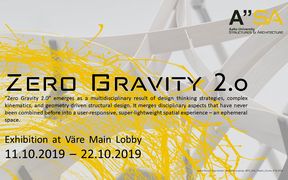

Otaniementie 14
School of Arts, Design and Architecture
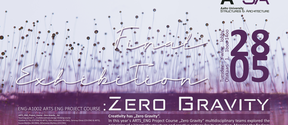
Visit to see students present the results of the ARTS-ENG Project Course in the Undergraduate Centre.
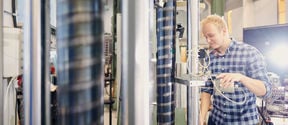
The Department of Civil Engineering aims to build the structures of tomorrow through research, education and collaboration.
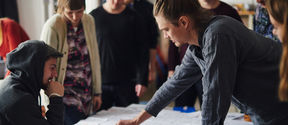
We train professionals to design human-centred environments.